ABS PONTIAC PONTIAC 1997 Owners Manual
[x] Cancel search | Manufacturer: PONTIAC, Model Year: 1997, Model line: PONTIAC, Model: PONTIAC PONTIAC 1997Pages: 419, PDF Size: 19.67 MB
Page 119 of 419
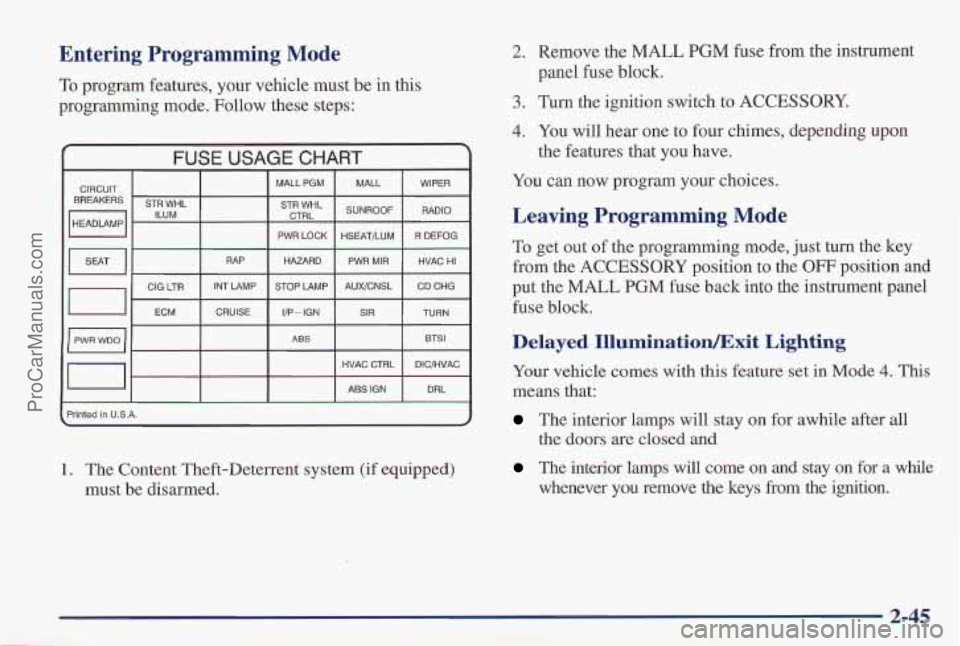
Entering Programming Mode
To program features, your vehicle must be in this
programming mode. Follow these steps:
FUSE USA
CIRCUIT
BREAKERS STR WHL
piq ILUM
RAP
0 ’ ECM CRUISE
CIG LTR
INT LAMP
0 PWR WDO
SE CHART
MALLPGM I MALL I WIPER
‘TT:FL I SUNROOF I RADIO I I PWR LOCK HSEATILUM
HAZARD PWR MIR
STOP LAMP AUWCNSL
I/P - IGN SIR
ABS
HVAC CTRL
ABS IGN
R DEFOG
HVAC
HI
CD CHG
TURN BTSI
DIC/HVAC DRL
I Printed in USA. I
1. The Content Theft-Deterrent system (if equipped)
must be disarmed.
2. Remove the MALL PGM fuse from the instrument
panel fuse block.
3. Turn the ignition switch to ACCESSORY.
4. You will hear one to four chimes, depending upon
the features that you have.
You can now program your choices.
Leaving Programming Mode
To get out of the programming mode, just turn the key
from the ACCESSORY position to the OFF position and
put the MALL PGM fuse back into the instrument panel
fuse block.
Delayed IlluminatiodExit Lighting
Your vehicle comes with this feature set in Mode 4. This
means that:
The interior lamps will stay on for awhile after all
the doors are closed and
The interior lamps will come on and stay on for a while
whenever you remove the keys from the ignition.
2-45
ProCarManuals.com
Page 132 of 419
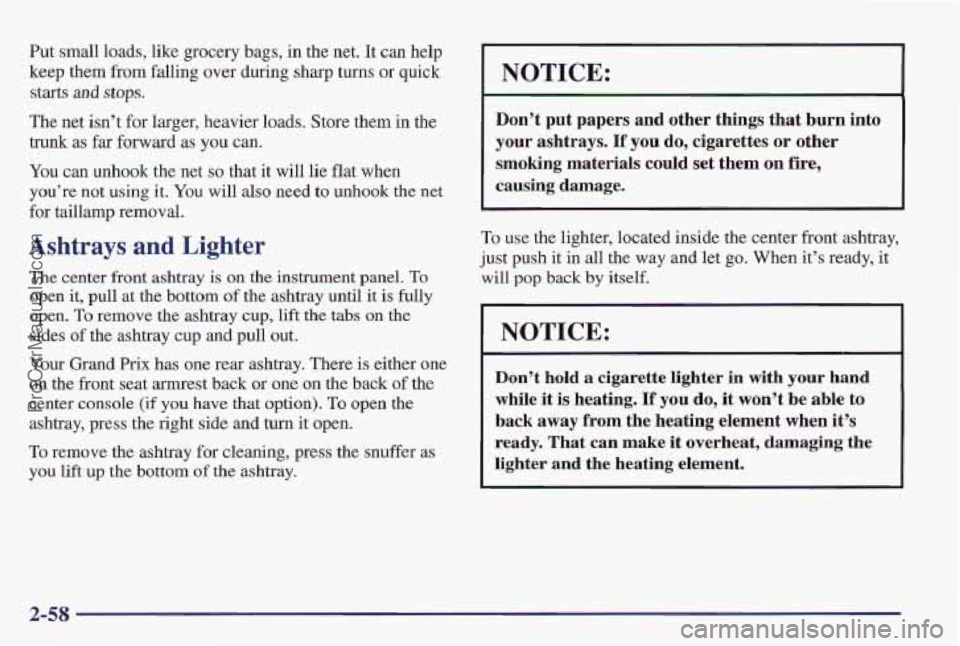
Put small loads, like grocery bags, in the net. It can help
keep them
from falling over during sharp turns or quick
starts and stops.
The net isn’t for larger, heavier loads. Store them in the
trunk as
far forward as you can.
You can unhook the net so that it will lie flat when
you’re not using it. You will also need to unhook the net
for taillamp removal.
Ashtrays and Lighter
The center front ashtray is on the instrument panel. To
open it, pull at the bottom of the ashtray until it is fully
open.
To remove the ashtray cup, lift the tabs on the
sides of the ashtray cup and pull out.
Your Grand Prix has one rear ashtray. There
is either one
on the front seat armrest back or one on the back of the
center
console (if you have that option). To open the
ashtray, press the right side and turn it open.
To remove the ashtray for cleaning, press the snuffer as
you lift up the bottom of the ashtray.
NOTICE:
Don’t put papers and other things that burn into
your ashtrays.
If you do, cigarettes or other
smoking materials could set them on fire,
causing damage.
To use the lighter, located inside the center front ashtray,
just push it in all the way and let
go. When it’s ready, it
will pop back by itself.
y. That can make it overheat, damaging the
2-58
ProCarManuals.com
Page 201 of 419
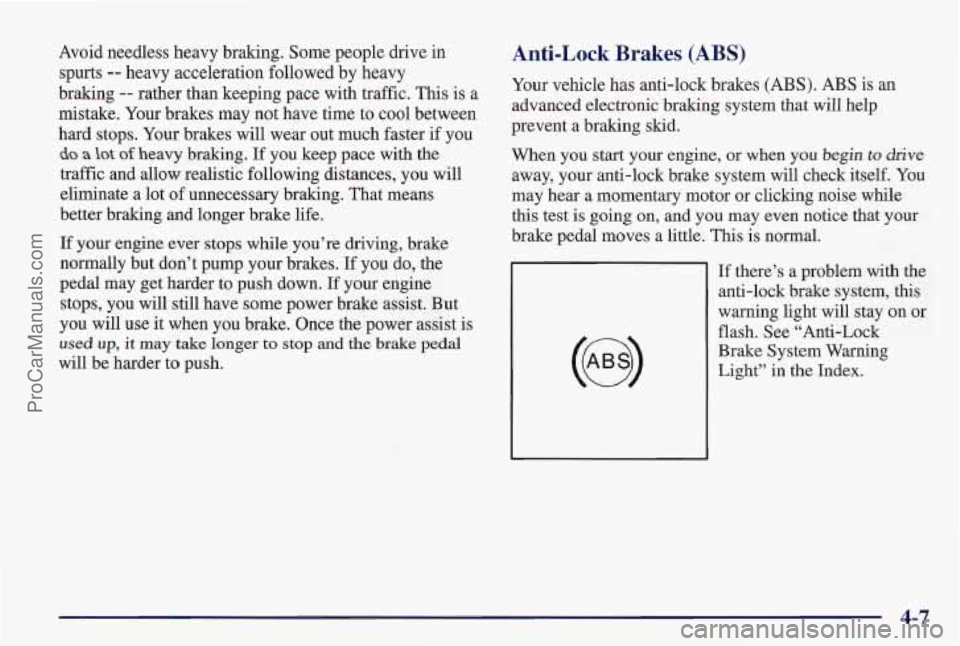
Avoid needless heavy braking. Some people drive in
spurts
-- heavy acceleration followed by heavy
braking
-- rather than keeping pace with traffic. This is a
mistake. Your brakes may not have time to cool between
hard stops. Your brakes will wear out much faster if you
do a lot of heavy braking. If you keep pace with the
traffic and allow realistic following distances, you will
eliminate a lot of unnecessary braking. That means
better braking and longer brake life.
If
your engine ever stops while you’re driving, brake
normally but don’t pump your brakes.
If you do, the
pedal may get harder to push down.
If your engine
stops, you will still have some power brake assist. But
you
will use it when you brake. Once the power assist is
used up, it may take longer to stop and the brake pedal
will be harder to push.
Anti-Lock Brakes (ABS)
Your vehicle has anti-lock brakes (ABS). ABS is an
advanced electronic braking system that will help
prevent a braking skid.
When you start your engine, or when you
begin to drive
away, your anti-lock brake system will check itself. You
may hear a momentary motor or clicking noise while
this test is going on, and you may even notice that your
brake pedal moves a little. This is normal.
If there’s a problem with the
anti-lock brake system, this
warning light will stay on or
flash. See “Anti-Lock
Brake System Warning
Light” in the Index.
4-7
ProCarManuals.com
Page 202 of 419
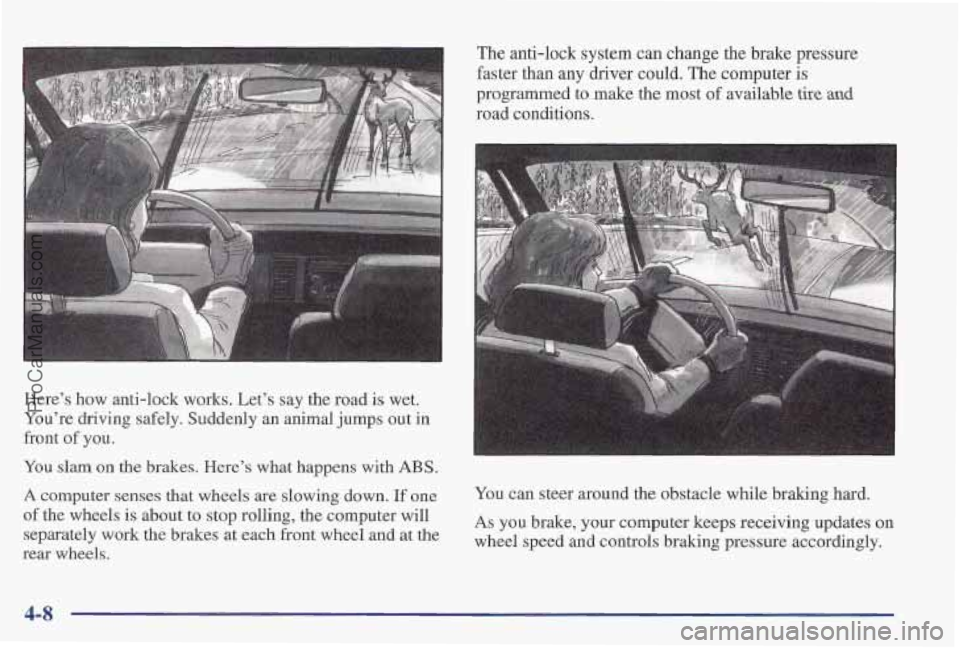
Here’s how anti-lock works. Let’s say the road is wet.
You’re driving safely. Suddenly an animal jumps out
in
front of you.
You slam
on the brakes. Here’s what happens with ABS.
A computer senses that wheels are slowing down. If one
of the wheels is about to stop rolling, the computer will
separately work the brakes at each front wheel and at the
rear wheels. The
anti-lock system can change the brake pressure
faster than any driver could. The computer is
programmed to make the most of available tire and
road conditions.
You can steer around the obstacle while braking hard.
As you brake, your computer keeps receiving updates on
wheel speed and controls braking pressure accordingly.
4-8
ProCarManuals.com
Page 209 of 419
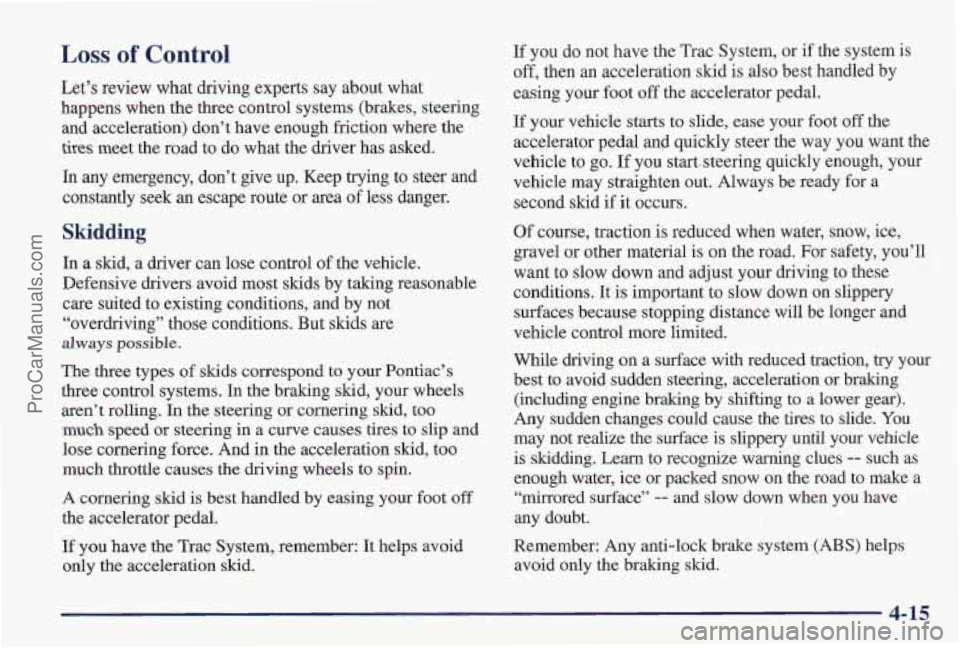
Loss of Control
Let’s review what driving experts say about what
happens when the three control systems (brakes, steering
and acceleration) don’t have enough friction where the
tires meet the road to do what the driver has asked.
In any emergency, don’t give up. Keep trying to steer and
constantly seek an escape route or area of less danger.
Skidding
In a skid, a driver can lose control of the vehicle.
Defensive drivers avoid most skids by taking reasonable
care suited to existing conditions, and by not
“overdriving” those conditions. But skids are
always possible.
The three types of skids correspond to your Pontiac’s
three control systems. In the braking skid, your wheels
aren’t rolling. In the steering or cornering
skid, too
much speed or steering in a curve causes tires to slip and
lose cornering force. And in the acceleration skid, too
much throttle causes the driving wheels to spin.
A cornering
skid is best handled by easing your foot off
the accelerator pedal.
If you have the Trac System, remember: It helps avoid
only the acceleration skid. If
you do not have the Trac System, or if the system is
off, then an acceleration skid is also best handled by
easing your foot off
the accelerator pedal.
If your vehicle starts to slide, ease your foot off the
accelerator pedal and quickly steer the way you want the
vehicle to go.
If you start..steering quickly enough, your
vehicle may straighten out. Always be ready for a
second slud
if it occurs.
Of course, traction is reduced when water, snow, ice,
gravel or other material
is on the road. For safety, you’ll
want to slow down and adjust your driving to these
conditions. It
is important to slow down on slippery
surfaces because stopping distance will be longer and
vehicle control more limited.
While driving on a surface with reduced traction,
try your
best to avoid sudden steering, acceleration or braking
(including engine braking by shifting
to a lower gear).
Any sudden changes could cause the tires to slide. You
may not realize the surface is slippery until your vehicle
is skidding. Learn to recognize warning clues -- such as
enough water, ice or packed snow on
the road to make a
“mirrored surface”
-- and slow down when you have
any doubt.
Remember: Any anti-lock brake system (ABS) helps
avoid only the braking skid.
4-15
ProCarManuals.com
Page 232 of 419

Parking on Hills
You really should not park your vehicle, with a trailer
attached,
on a hill. If something goes wrong, your rig
could start to move. People
can be injured, and both
your vehicle and the trailer can be damaged.
But
if you ever have to park your rig on a hill, here’s
how to do it:
1. Apply your regular brakes, but don’t shift into
2. Have someone place chocks under the trailer wheels.
3. When the wheel chocks are in place, release the
regular brakes until the chocks absorb the load.
4. Reapply the regular brakes. Then apply your parking
brake, and then shift to
FARM (P).
5. Release the regular brakes.
PARK (P) yet,
When You Are Ready to Leave After
Parking on a Hill
1. Apply your regular brakes and hold the pedal down
while you:
Start your engine;
Shift into a gear; and
0 Release the parking brake.
2. Let up on the brake pedal.
3. Drive slowly until the trailer is clear of the chocks.
4. Stop and have someone pick up and store the chocks.
Maintenance When Trailer Towing
Your vehicle will need service more often when you’re
pulling
a trailer. See the Maintenance Schedule for more
on this. Things that are especially important in trailer
operation are automatic transaxle fluid (don’t overfill),
engine oil, belts, belt, cooling system and brake
adjustment. Each
of these is covered in this manual, and
the Index will
help you find them quickly. If you’re
trailering, it’s a good idea to review these sections
before you start your trip.
Check periodically to see that all hitch nuts and bolts
are tight.
4-38
ProCarManuals.com
Page 338 of 419

FUSE USAGE CHARY 1
CIRCUIT MALL PGM
WIPER
K I HSEAT/LUM 1 R DEFOG I
SEAT
CIG LTR INTLAMP STOP LAMP AUXlCNSL
CD CHG
CRUISE I/P - lCiN TURN I I I I
ABS ETSl
ABS IGN
Printed in U.S.A.
Circuit Breaker
Description
HEADLMP
Headlamps
PWR SEAT Power Seat, Power Lumbar
PWR
WBO Power Windows
Fuse Description
MALL PGM Mall Module -- Program
MALL Mall
Module
Fuse
WIPER
STR WHL ILUM
STR WHL CTRL
SUNROOF
RADIO
PWR LOCK
HSEATLUM
R DEFOG
RAP
HAZARD
PWR MIR
HVAC HI
CIG LTR
INT LAMP
STOP LP
AUXKNSL
CD CHGR
Description
Wipers
Steering Wheel Illumination
Steering Wheel Control
Sunroof
Radio, Antenna
Mall Module
-- Power Locks
Heated Seats, Power
Lumbar
Rear Defog
Retained Accessory Power,
Mall Module
Hazard Flashers
Power Mirrors
HVAC Blower -- Hi
Cigarette Lighter,
ALDL, Floor
Console Auxiliary Outlet
Mall Module-Interior lamps
Stoplamp
Auxiliary Power, Overhead Console
CD Changer
6-68
ProCarManuals.com
Page 339 of 419
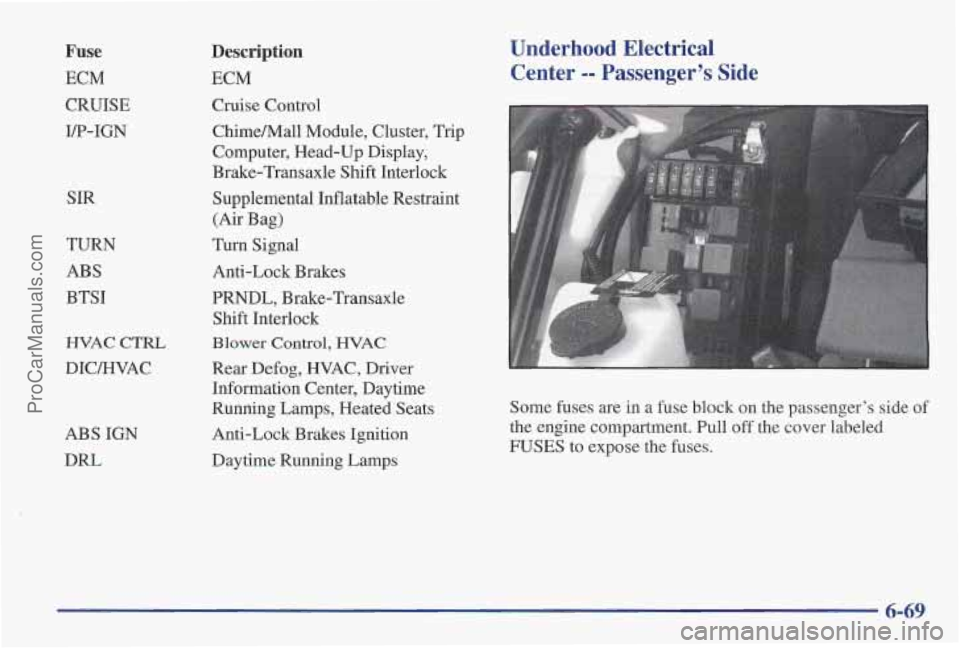
Fuse
ECM
CRUISE
I/P-IGN SIR
TURN
ABS
BTSI
HVAC CTRL
DIC/HVAC
AB’S IGN
DRL
Description
ECM
Cruise Control ChimeMall Module, Cluster, Trip
Computer, Head-Up Display,
Brake-Transaxle Shift Interlock
Supplemental Inflatable Restraint
(Air
Bag)
Turn Signal
Anti-Lock Brakes
PRNDL, Brake-Transaxle Shift Interlock
Blower Control, HVAC
Rear Defog, HVAC, Driver
Information Center, Daytime
Running Lamps, Heated Seats
Anti-Lock Brakes Ignition
Daytime Running Lamps
Underhood Electrical Center
-- Passenger’s Side
Some fuses are in a fuse block on the passenger’s side of
the engine compartment. Pull off the cover labeled
FUSES to expose the fuses.
6-69
ProCarManuals.com
Page 341 of 419
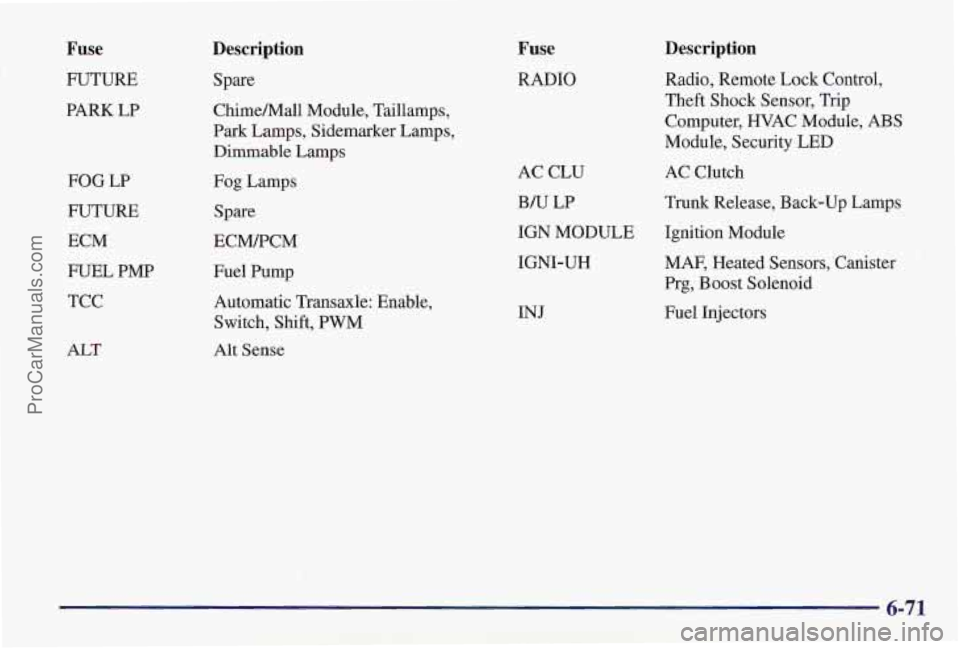
Fuse
FUTURE
PARK
LP
FOG LP
FUTURE
ECM
FUEL PMP
TCC
ALT
Description
Spare
Chimemall Module, Taillamps,
Park Lamps, Sidemarker Lamps, Dimmable
Lamps
Fog Lamps
Spare
ECM/PCM
Fuel Pump
Automatic Transaxle: Enable,
Switch, Shift,
PWM
Alt Sense
Fuse
RADIO
AC CLU
Description
Radio, Remote Lock Control,
Theft Shock Sensor, Trip
Computer, HVAC Module, ABS
Module, Security LED
AC Clutch
B/U LP
Trunk Release, Back-up Lamps
IGN MODULE
Ignition Module
IGNI-UH
INJ MAF,
Heated Sensors, Canister
Prg,
Boost Solenoid
Fuel Injectors
6-71
ProCarManuals.com